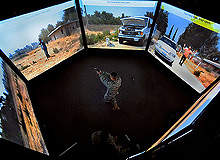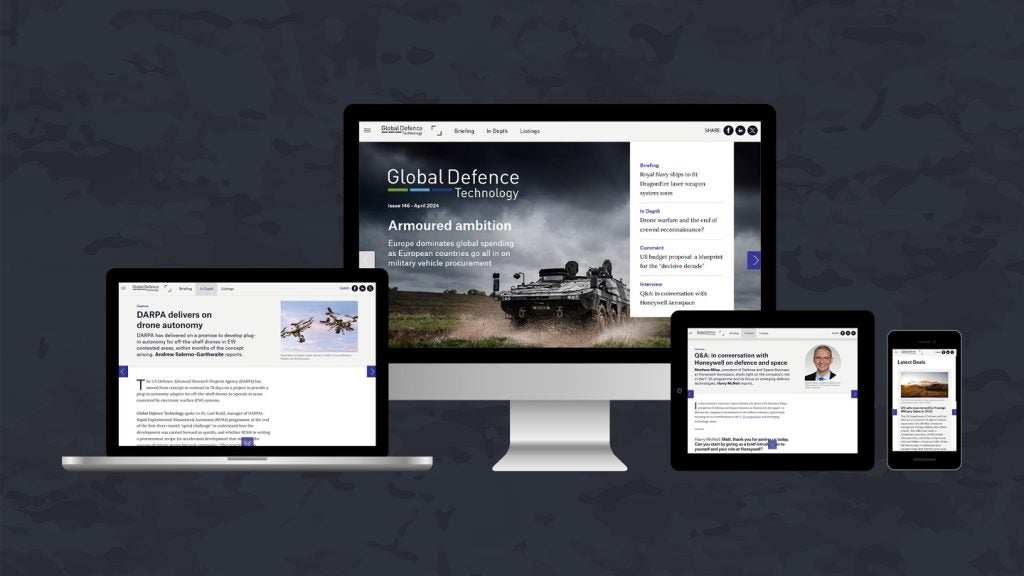
For years, live training has been the method of choice for the military. However, as the lethality, expense and complexity of modern weapon systems increases, and training budgets tighten, it is no longer sufficient as a sole training method.
In order for standards and output to be sustained, live training must be augmented and complemented through virtual and constructive training. But determining the best mix of these is a complex challenge.
A three-legged race
The analogy of a three-legged stool might be useful. Each leg represents one of the three elements of training: live, virtual and constructive.
If any of the legs are too short then the entire stool will be unstable and may fall. This is not to say that it is necessary to maintain an even distribution across the three legs, but merely that consideration must be given to each to achieve an overall balance.
To take the analogy further, even a balanced stool may be too short to support or deliver the required level of operational output, and merely lengthening one leg to increase the overall height will fail to deliver what is needed. Therefore, all legs of the stool must be addressed to ensure that the training system is balanced and at the correct level to meet operational requirements.
The current approach to training features legs of different lengths and a stool that is precariously out of balance. If action is not taken to address this there is a risk the system will topple and fail to deliver the outcomes that are needed.
How well do you really know your competitors?
Access the most comprehensive Company Profiles on the market, powered by GlobalData. Save hours of research. Gain competitive edge.

Thank you!
Your download email will arrive shortly
Not ready to buy yet? Download a free sample
We are confident about the unique quality of our Company Profiles. However, we want you to make the most beneficial decision for your business, so we offer a free sample that you can download by submitting the below form
By GlobalDataAt present it would appear the stool is imbalanced due to the fact that the live-training leg is significantly longer than the other two. However, an equally worrying factor is the insidious reduction in the height of the stool brought about by budgetary pressures, which have forced the shortening of this particular leg. In other words, not only has the level of training been reduced without any compensating measures, but action has not been taken to bring balance to an imbalanced situation. Training gaps have appeared and an urgent assessment of investment across all three areas is required to establish equilibrium at the appropriate level.
Artificial intelligence
Synthetic training has the potential to fill the existing gaps, both as a partial replacement for live training and a way of better delivering operational capability. This potential has already been proven in a number of instances but there is an urgent prerogative to take this further. In many cases virtual training capabilities remain isolated due to the fact that they were developed independently and are not easily interoperable. This not only manifests as a lack of coherency across the live, virtual and constructive training environments, but also across the individual, team, group or collective training domains. If these ‘stovepipes’ can be dismantled, the resultant capability is impressive.
The success of capability concept demonstrators and similar initiatives, allied with advances in technology, has led to a greater appetite for synthetic training, and emerging and future technologies. However, in order to fill existing training gaps. It is clear that defence ministries and departments must first develop a coherent and comprehensive joint training and simulation strategy. This strategy must determine the level of training fidelity required for each military task and specify the clear apportionment of live, virtual and constructive training. With skill-fade and hibernation becoming apparent in some capabilities it is evident that existing training structures, delivery and equipment do not effectively provide this apportionment. Consequently there has been a failure to make full use of the synthetic training environment to properly complement live activity.
Such a strategy is but one step towards achieving an optimal blend of live and synthetic training. Procurement strategies and embedded generational attitudes must also be challenged. Furthermore, safety must be considered upfront and a minimum safe level of live training must be maintained. With increasing pressure to reduce live activity, a failure to introduce a strategy to address all of these aspects will result in an imbalance between live and synthetic training and, as a consequence, continued and significant operational capability gaps.
Mission impossible?
The size and complexity of the modern battlespace is difficult, if not impossible, to reproduce at the correct scale in a live training environment. Moreover, the next generation of precision weapons may prove too expensive or too demanding of current airspace and weapons ranges for live training to continue at the same level. A significant proportion of key enablers are committed to enduring operations and thus unable to support training.
Live training is also coming under increasing economic and environmental pressure, and in light of this the call for the wider use of synthetic technology is almost irresistible. However, affordable synthetic technology does not fully replicate the physical, psychological and emotional pressures experienced during live activity, so it must be viewed as complementary and not as a substitute or replacement. On the plus side, synthetic training can offer a level of immersion and scale that is not achievable in the live arena, it is repeatable and cost-effective, and provides a safe environment in which to assimilate and acquire skills.
Moreover, synthetic training allows for the creation of richer settings than conventional training solutions alone.
The cost of training will be a huge driving factor, and it is interesting to note that the cost efficiencies expected by increasing the proportion of synthetic training are not as great as one might expect. Assuming that training effectiveness can be transferred from a live scenario to a simulator on an equal basis – something open to conjecture – any potential savings can only be realised through the acquisition of fully distributed synthetic training networks, and these do not come cheap. The problem is also exacerbated by the relatively poor state of most synthetic inventories.
For example, most air forces struggle to achieve ratios of better than 75:25 in their live/synthetic balance. There are some notable exceptions that help to illustrate that it is possible to achieve a fundamentally different balance and still deliver exceptional operational capability and readiness – the US Air Force’s fast jet readiness aircrew programme for the B-2 delivers a 50:50 ratio. That said, military air forces remain far short of the mark set by the civilian airlines that operate zero flight-time rated schemes, with all training conducted in the simulator. It is true to say that the motivations for this are primarily financial, but this training is still subject to equally strict safety requirements.
The optimal live-synthetic blend can be determined through a defence-wide application of a systematic approach to training. This approach, which is widely applied across industry, aims to determine the level of training of an individual, team, group or collective by analysing the training need, selecting the most appropriate media to deliver it and maintaining the standard through an independent and auditable review process. All training must be directly linked to operational tasks, and routinely and independently evaluated. When required, changes must be made to the training system to maintain effective and efficient delivery.
The adoption of a systematic approach allows for the derivation of mission-essential competencies to establish the requisite knowledge, skill and experience, and determine where gaps exist in the training regime. Once determined, the training requirement can then be quantified, recorded and audited. A simultaneous audit of the synthetic training environment should determine if the synthetics are fit for purpose in terms of safety and functionality, and identify technical deficiencies. The output of both audits should be used to confirm the training system and inform the procurement cycle.
Generation games
The challenge for proponents of synthetic training is to provide a standard of synthetic equipment that is not only safe and fit for purpose, but also attractive as a training tool to the trainee and trainer. Although synthetic training may not fully replicate live activity, the gap is closing and the required level of training fidelity for each task must be determined and matched to the available media to make efficient use of live and synthetic training opportunities.
If the synthetics are antiquated or unrepresentative of the platform, negative attitudes are formed. Many older hands have a negative attitude toward simulation and look for minimal exposure, opting instead to conduct the majority of their training in the live domain, but this practice is both wasteful and expensive.
In contrast, the younger generation has a much more positive attitude to synthetic training, but the standard of equipment must be improved if this optimism is to be properly nurtured. This is a generation exposed to synthetic media at a much younger age, with which it is instinctively familiar and increasingly reliant upon. It is also a generation willing to experiment with such media rather than be restricted by it. It is important to capitalise on this attitude, which serves to reinforce the case for improved synthetics and a better coherence between aircraft and synthetic platforms.
The implementation of a joint and combined training strategy to optimise live and synthetic training will be a complex challenge, and one that will require a comprehensive review and continual audit of training requirements, its delivery and associated equipment. However, the potential financial benefits of increasing synthetic training can only be realised if there is an agreed strategy for legacy simulation systems and a policy to ensure coherency between synthetic and live platforms. The continual audit of the training system must inform the procurement process so that it can keep pace with refresh rates and exploit emerging commercial technology. An incremental approach is unlikely to keep pace with future defence reviews, acquisition cycles or technology refresh rates. Failing to approach the task holistically risks creating a dangerous imbalance of the three-legged stool. Reality suggests an inexorable reduction in live activity, and it is clear this must be counterbalanced with an increase in synthetic training. If not, training gaps and shortfalls will be created, the overall level of the stool will be reduced and operational capability will be lost.
Clearly, there must be a number of safeguards in place before we set off along the path to the greater use of synthetic technology. Further analysis is required to determine the minimum levels of live activity for safety reasons, and to prepare personnel for the physical and psychological demands placed on them during operations.
In addition, to enable synthetics to shoulder a greater portion of training, a fully distributed network of interoperable live and synthetic platforms and sensors must be established. This transition requires a significant shift in culture, and will inevitably challenge the attitudes of many. However, there is little option but to better balance the stool. To do so in the face of severe resource constraints is difficult, but it would appear that there is no better option than to fully embrace the potential of synthetic.
This article was first published in our sister publication Defence & Security Systems International.





